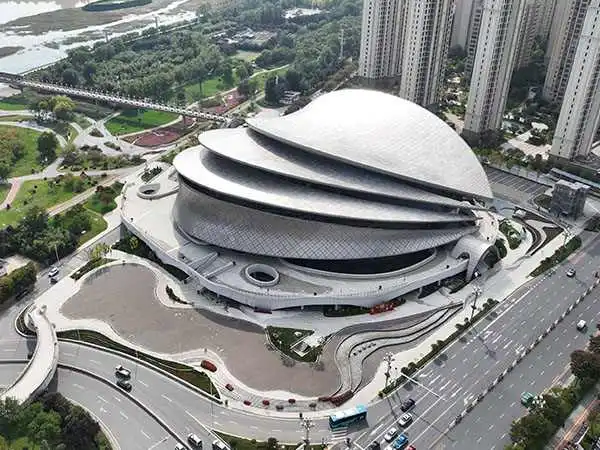Building Use:Cultural arts
Area:12000m²
Steel Usage:4500t
Factory Structure and Project Features:Steel structure frame
Project Challenges & Overcoming Process:Complex shape, numerous nodes, huge volume, many irregular components, and high precision requirements.

The use of steel structures in opera houses, while not always the primary material for the most iconic architectural features, plays a crucial role in their construction and engineering. While famous opera houses like the Sydney Opera House are more known for their innovative use of concrete, steel is a critical component for achieving the large, open, and structurally complex designs that define modern performing arts venues.
Foundation and Substructure: In projects like the Oslo Opera House, steel piles are used for deep foundations, providing a stable base in challenging soil conditions. The Copenhagen Opera House also utilized steel components within its foundation and substructure.
Roof Structures: Steel is ideal for creating large, clear spans without the need for internal columns. The cantilevered roof of the Copenhagen Opera House, for example, is a closed steel box, which provides exceptional rigidity and allows for the vast, open spaces of the foyer below. Similarly, the roof of the main stage at the Oslo Opera House rests on a steel structure.
Structural Framework: Steel is used for the overall structural framework of the building, providing strength, durability, and the ability to support heavy loads. This includes the main building frame as well as internal structures for things like the stage and rigging.
Specialized Components: Steel is also used for a variety of specialized elements, such as hydraulic lift legs for orchestra pits, tensioning assemblies for floors, and beams and trusses that support balconies and other architectural features.
The use of steel in large-span buildings like opera houses offers several key advantages for both architects and engineers:
High Strength-to-Weight Ratio: Steel is incredibly strong for its weight, which allows for lighter foundations and more efficient use of materials.
Large Clear Spans: Steel's strength and ductility make it possible to create large, open, unobstructed spaces, which are essential for auditoriums, stages, and foyers. This is often achieved using steel plate girders or trusses.
Design Flexibility: Steel is a versatile material that can be shaped and fabricated into complex and innovative forms. This allows architects to achieve unique and ambitious designs that would be difficult or impossible with other materials.
Speed of Construction: Many steel components are prefabricated off-site, which significantly reduces construction time and on-site labor costs.
Durability and Resistance: Steel is resistant to a number of environmental factors, including pests, and when properly treated, can be protected from corrosion. It also performs well under dynamic loads, such as those caused by wind and seismic activity.
Building an opera house with steel isn't without its challenges, primarily related to the very specific needs of a performance venue.
1. Acoustics: The Ultimate Challenge
Steel is a highly resonant material. If not handled correctly, a steel structure can vibrate, ring, and transmit unwanted noise from subways, traffic, or even the building's own HVAC systems into the pristine acoustic environment of the auditorium.
Solution: The "Box-in-a-Box" Design. This is the gold standard. The main auditorium is constructed as a structurally separate "box" (often of concrete and wood) that sits inside the main steel superstructure. It is acoustically isolated using specialized neoprene or rubber pads, creating a buffer that stops vibrations from being transmitted.
2. Fireproofing:
Steel loses its structural integrity at high temperatures. In a large public assembly building like an opera house, fire protection is paramount.
Solutions:
Intumescent Paint: A coating that swells up when heated to form an insulating char layer.
Spray-Applied Fireproofing: A cementitious or fiber-based material sprayed directly onto the steel.
Encasement: Boxing the steel columns and beams in concrete or fire-rated drywall.
3. Thermal Bridging:
Steel is an excellent conductor of heat, meaning it can create a "bridge" for heat to escape in the winter or enter in the summer, leading to energy inefficiency and condensation.
Solution: Thermal Breaks. Insulating materials are strategically placed to break the continuous path of steel from the inside to the outside of the building envelope.

Create the greatest value for customers
Provide the best quality products and services
+8618800767079
info@hcggsteel.com
No.1 Shuangxiang Road, Luoxin Industrial Park, Luoyang City